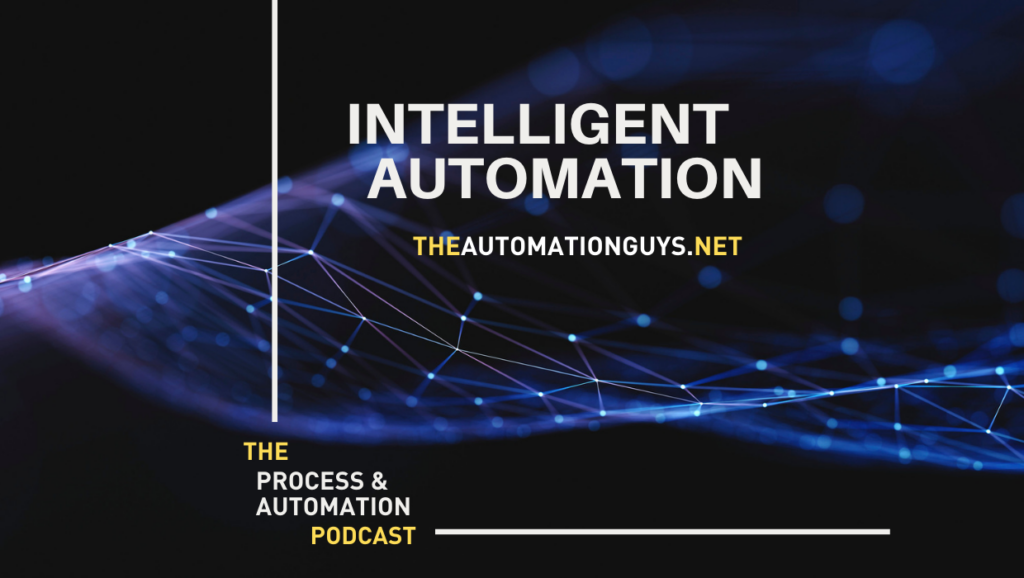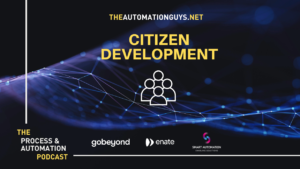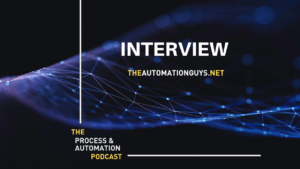Blog

In today’s episode, The Automation Guys go through a list of questions often asked by the podcast audience and also asked from the community around the topics of RPA and Intelligent Automation. Feel free to send us more of these questions on our community or via our social channels or via our website www.theautomationguys.net.
Share This Post
The #1 source of knowledge for everything automation: https://theautomationguys.net
Do you have any questions? Would you like to give us feedback? Are you interested in workshops on the topic of automation? Are you an expert in the field of automation and would like to be on the podcast? Let us know: https://bit.ly/3lyq9Yj
Episode Transcript
Sascha: Hello and welcome back to another episode of the Process and Automation podcast with The Automation Guys. In today’s episode, we go through a list of questions we often get asked by our audience and from the community around the topics of RPA and intelligent automation. So hopefully our answers to these questions we have collected are helpful for you and of course, please feel free to send us more of these questions on our community or via our social channels or via our website theautomationguys.net. So Arno, what do we have as our first question from the audience?
Arno: So the first question, Sascha, is what is RPA? And to put it simply, RPA is the technology that allows organizations to use software robots to perform specific task in an automated way.
So using a combination of user interface interaction, for example, descriptor technologies and cognitive processes, RPA bots can be used to mimic or to emulate, uh, selected tasks within an overall business or IT process, for example. So these may include manipulating data, passing data to and from different applications, triggering responses or just simply executing transactions.
Um, so these RPA bots can, work through one or many different software applications and it really, again, kind of mimics human behaviour. So you can train it to do specific things that a human would usually do, but it, it, it does it really quickly.
Sascha: All right. Yeah, that sounds interesting. Yeah.
Cool. Um, uh, I’ll grab the next one, uh, from the audience. Um, uh, the question here is what is intelligent automation? Yeah. So we get that very often. Um, as a question, so when talking about intelligent automation, um, so. We, we think, um, it goes beyond RPA. So Arno just mentioned what RPA is, but intelligent automation goes really further.
So, um, to intelligently automate means take RPA technologies and enhance it with artificial intelligence AI, machine learning, and bring in other technologies as well. And that will allow for more custom and intelligent design of the process automation and can be implemented of course, across, uh, departments and the whole organization.
And, um, yeah, we also, uh, very often say intelligent automation, will enable businesses to move towards hyper automation. So there’s another buzzword, um, we will cover in in the questions later.
Arno: So the next question that’s commonly asked is, can RPA work in any software application? And the answer to that one is yes.
Um, generally, RPA is fully agnostic, and it could be used to automate and integrate data in any application. And this could be applications on premise or in the cloud and in any interface or server, including terminal server systems like Citrix Remote Desktop. Um, so again, if a human can interact with an application, a robot can do exactly the same.
Sascha: So, um, the next one is, what is process mining? So when we talk about process mining, We talk about setting, uh, as we’re talking about a set of solutions that looks at event locks, uh, at the event data timestamps and so on that are generated by, um, a series of systems, enterprise systems like an ERP system, CRM system, uh, HR system, so all sorts of other systems maybe supply chain management tools. Um, yeah, and to rebuild, um, uh, a virtual view of the processes and, and the process, how they’re actually running that’s a big, big difference to, um, what we, what we do a lot in, in process documentation.
So, yeah. And process mining tools we very often talk about, um, data should be robust and powerful. So these, these process mining tools can blend data mining with, with other technologies like, AI and machine learning to generate data based analytics. And that will help organizations discover state of business processes. As I mentioned it will really show us how processes actually running and that will identify opportunities for optimization and automation. Um, also when we talk about process mining, um, we talk about that it is a part of multiple stages of this typical RPA lifecycle. Very early on we use process mining to identify, uh, identify processes that are really good candidates for automation. We analyse it to the extent to which RPA can be implemented in old processes, old systems, and later it will also provide additional monitoring analysis. Um, and we can look at that data and see how our RPA performs and really can derive further improvement on from that. Um, yeah, so as, as you all know, we have done several in-depth episodes on process mining already so I do recommend to everyone to listen back to some of our older episodes. And, uh, yeah, we will link, um, to those episodes in our show notes as well.
Arno: Great. Thanks Sascha. Um, so the next one is a common one as well. People ask us is, how do I get started with RPA? And, you know, what we’ve done is kind of just created a, a, a little, uh, a few steps, simple steps as a guide for business and IT leaders, um, you know, to develop, um, their RPA implementation strategy, um, to ensure that, you know, it’s successful and also scalable, uh, in the future.
Um, so obviously the first step would be to, um, to reach out to us in our community or via social media channels. Um, you know our community automation experts can help, help you and assess you or, you know to really, um, kickstart your RPA journey and your intelligent automation journey as, as well as help you to identify those opportunities.
And you would like to sort of, uh, just look at RPA yourself, uh, as an initial step. Um, I think the most important one there is to build a RPA business case. Typically look at your processes look at how automation can improve and streamline these processes and really extract the sort of, or highlight the, the hard and soft benefits.
Hard benefits is obviously financial savings. Soft benefits is things like customer satisfaction because, you know, digital workers don’t make mistakes, so customer retention is high. Um, so, so, so there’s numerous of these benefits. Um, the third one on the list is to determine your, you know, most optimum operating model.
So your target operating model needs to be, uh, defined for RPA, you know, how will you work with your new digital workforce? And then the fourth is really to plan out your automation roadmap and your RPA governance plan. So sit down, look at how you want to bring, RPA and automation into your business, and also how you want to govern this.
You know, how you want to set up IT governance to make sure that, um, you know, your processes are, um, you know, scalable, um, they’re properly managed and they’re also available, you know, especially when it’s business critical processes.
Sascha: Yeah. Cool. Thank you. Arno. Um, so yeah, the next, uh, question we have, we get that asked quite often in general in the beginning of projects as well. What are the challenges of RPA? There are indeed multiple challenges that can appear when implementing, uh, robotic process automation in your department or, yeah, the whole organization. And let’s go through, um, three of them. And the first one we see is that employee are resistant.
Um, and, um, so really get them started. That’s of course, uh, like with every other technology and, and general technology implementation, um, it results into change and people do not like change. So that can result in stress for employees. So in the case of RPA, um, there’s also the belief that, uh, automation equals to people, um, uh, have to, have to leave, firing people, layoffs, that kind of stuff. So creating some adoption resistance, therefore you, so that’s, uh, that’s definitely a big thing we have to work when, when we bring this technology into, into, uh, organizations. Um, another challenge of course is selecting the right processes.
We talked about the process mining. It could identify really good candidates. It’s very vital to really identify which processes are suitable for RPA so that automation can run successful? And, um, and this requires an in-depth analysis, um, and should not be really rushed to deploy.
Um, So this will most certainly, uh, otherwise lead to failure. And of course, uh, it’s not meeting the expectations, uh, of, of these departments and organizations. Uh, and of course that there will produce trouble with employees again. So they, they become even more resistant if we are even choosing the wrong processes.
Yeah. And, uh, yeah, and of course setting realistic RPA expectations. So that’s super important. Companies need to really recognize the limits of what RPA can do and understand the RPA will not really, is suitable for every, every broken process in a company. So, yeah, I think this, these three, um, points, um, are most of the, sort of the biggest challenges of RPA.
Arno: Right. So the final one, um, and then, and it’s actually two, but I’ll combine it into one. Um, the first question Is what is hyper automation and I’ll sort of give you a, a, a textbook, um, definition of it whereby it says that, um, it is a strategic enterprise initiative that can deliver a continuous automation journey with superior business outcomes by leveraging a combination of technologies that complements the core RPA adoption.
What, what we are seeing here is with inside the hyper automation definition is it’s really, um, core RPA in the middle, and then all of the sort of other technologies, complimentary technologies that surrounds it to deliver this so-called hyper automation. And that kind of blends in to the next question as well, you know, what does the future look like for RPA?
And, you know, again, according to the, the Gartner’s list of top 10 strategic technology trends, um, the evolution of RPA as we know it into hyper automation, is the number one trend. So again, expanding the automation from RPA to a combination of, um, other cognitive technologies like ai, um, machine learning, natural language processing, uh, OCR, computer vision, you know, that that enables this sort of end-to-end automation life cycle.
So again, I think those, those two questions are, are linked to each other. To get started people usually get started just with RPA, but again, most RPA vendors are building these sort of progressive, uh, progressive sort of, um, uh, technologies that’s complimentary to AI that really enables the, what’s called this, this hyper automation.
Sascha: Cool. Yeah. Thank you very much Arno. I hope these, uh, answers to the questions from the community and from the social channels are helpful. Um, good summary of what these technologies, what RPA is, what hyper automation is intelligent automation is. We will put information to other episodes we covered earlier in the show notes.
And, uh, yeah, thanks for listening and until next time, let’s automate it.
Unfortunately. That’s it again with this episode of the Process and Automation Podcast. If you liked this episode, please give us a five-star rating and don’t forget to subscribe to this podcast so you don’t miss any upcoming episode. We hope you will tune in next time and until then, let’s automate it.
- October 16, 2022
- 7:48 pm


